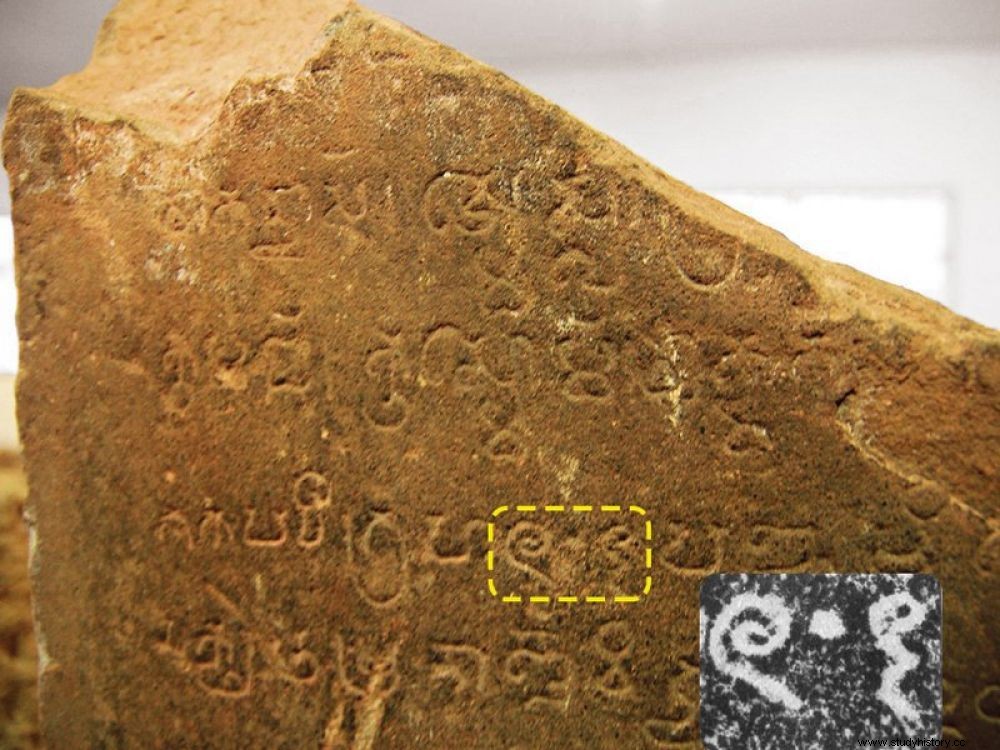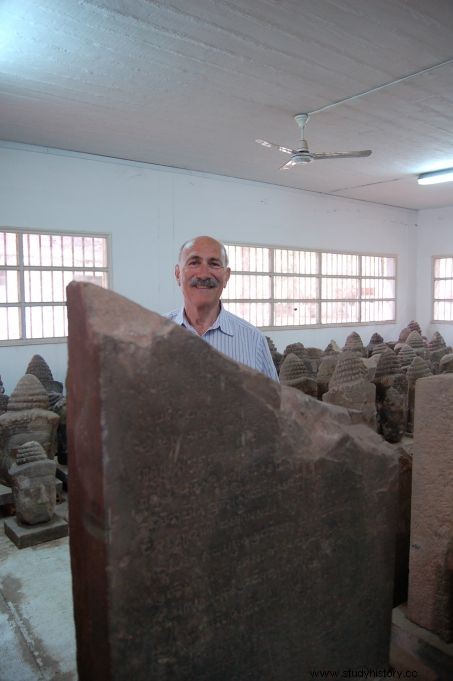An exhibition at the National Museum of Phnom-Penh in Cambodia is the setting for an exciting discovery:a stele bearing the oldest "0" that has come down to us. A point engraved in the rock.

This inscription in ancient Khmer, the point on the right, would be the oldest known version of our zero. It reads:"Year 605 of the Çaka era, the fifth day of the waning moon...".
It is apparently a simple sandstone monolith labeled K-127 on which is engraved a very old bill of sale referring to slaves, five pairs of oxen and sacks of white rice.... However, the date mentioned, "605 of the çaka era would make it no less than the earliest known mention of our zero! Or the VII e century instead of the IX th as experts have long thought. Presented to the public since the beginning of January in the magnificent museum of Phnom-Penh (Cambodia), as reported by the daily The Cambodia Daily , this stele was rediscovered in 2013 after several years of research by Amir D. Aczel, an American mathematician from Boston University. As he had then told Sciences et Avenir (n°797), he had been interested in numbers since childhood and this passion had prompted him, later, to go in search of the oldest known zero of the old world.
For a long time, specialists believed that the oldest zero ever found was in India
Let us recall that with the exception of the Mayan system - which already used a zero glyph but considered by specialists as a mathematical dead end - it was not popularized in Europe until 1202 by the Italian mathematician Fibonacci ( Leonardo of Pisa) in his "Book of Abacuses", the Liber Abaci . Its position in a number made it possible to make the difference between 15, 105 and 150 for example. The Italian mathematician would have learned it from Arabic traders, who had undoubtedly adopted it themselves during trips to Asia.

Amir D. Aczel next to stele K-127, when it was rediscovered in the warehouses of the Angkor Conservation, in Siem Reap (Cambodia). © Amir D. Aczel.
For a long time, specialists therefore estimated that it was in India, in the temple of Chatur-Bujha, in Gwalor, that the oldest zero ever found was found, dated to the IX e century. "Until I meet that monolith further east Amir D. Aczel told us then, who went on a track after reading a publication by the French epigraphist Georges Coedes (1886-1969) dated 1931. This expert in ancient Khmer - the ancient idiom of Cambodians - had indeed published the translation of a lapidary inscription engraved on a stele found in 1891 in ruins located in the heart of Cambodia. It included the date "605 of the Çaka era engraved with a dot between two numbers. "Knowing that this Indian era had begun in 78 CE, this first zero therefore dated from 683 (605+78) enthused Amir D. Aczel. Or the VII e century. But where to find this precious relic? What had become of this stele after the decades of drama that Cambodia had experienced in the 20 th century under the Khmer Rouge dictatorship? In fact, after years of investigation in Thailand, Laos, Vietnam and Cambodia, the American mathematician finally found it... in the warehouses of the Conservation of the Angkor site, in the middle of broken lintels and hundreds of remains of statues preserved in the small town of Siem Reap, not far from the famous temples.

The National Museum in Phnom-Penh, Cambodia, where Stele K-127 is currently on display. © Bernadette Arnaud
Amir D. Aczel, who recounted his adventure in an article in Smithsonian magazine as well as in a bestselling book titled Finding Zero* (not translated in France), unfortunately did not have the joy of attending the exhibition which pays homage to him at the Phnom Penh museum where the famous stele now appears. He died of cancer in November 2015 at the age of 65.
To find out more:a video
*Finding Zero:A Mathematician's Odyssey to Uncover the Origins of Number , 2016, MacMillan
